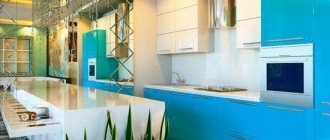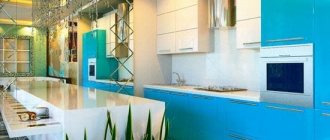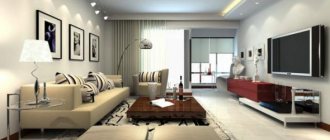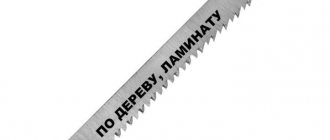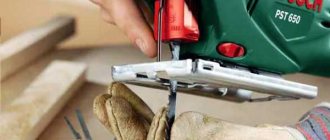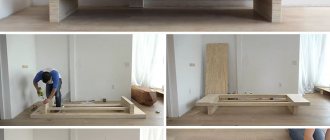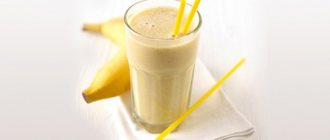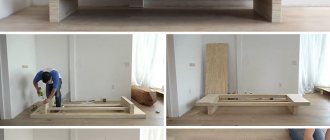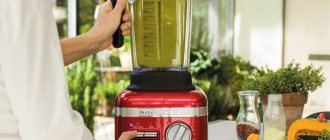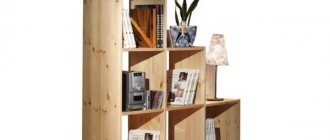Self-adhesive film is a material familiar to many. But today it is experiencing new life in a budget-friendly interior update. And kitchens too. The reason is that the quality of such materials and the variability of design are growing - you can find self-adhesive on sale not only with the usual wood pattern, but also with marble, stone, tile patterns, just plain matte or glossy surfaces. Our selection includes inspiring examples of updating kitchens using self-adhesive film.
How to choose film for furniture?
Even a family with a small budget can afford to update their kitchen using film. Kitchen furniture can be pasted onto almost any surface: MDF, plastic, chipboard and other materials.
There are many options for updating your kitchen set using film decor, which is quite simple to work with.
Not all adhesive options are suitable for long-term indoor use. When choosing a material, the following criteria must be taken into account:
- quality and thickness of decor;
- manufacturer;
- the condition of the furniture being pasted;
- risk of damage;
- aesthetics.
The material is offered in matte and glossy, while the finish can be wood, ceramic, velor, mirror, with patterns, etc. As for the range offered, it all depends on your taste and imagination.
Classification by structure
Self-adhesive film for kitchen facades can have different structures:
| Single layer. | In the manufacture of such material, pigments, stabilizers and plasticizers are added to organic substances. The glue is placed on the back side and covered with paper on top. To update your kitchen design, you need to peel off the paper and apply the film to the surface with the adhesive side. |
| Double layer. | In this option, the base and cover are made separately. Fabric or paper is used as a base, and polyvinyl chloride resin with various additives is used as a cover. The varying degrees of stability of the material depend on the method of manufacturing the cover. |
If you compare the price of these options, the second one will be more expensive.
Material of manufacture
Self-adhesive film consists of several components, but it is classified depending on the base. It could be:
- Polyvinyl chloride. Given its low cost and durability, vinyl film is considered the most popular option. It is not afraid of moisture and is resistant to temperature changes, which is important when using it in the kitchen.
- Propylene is the most wear-resistant material.
- Polyester is a material that looks like fabric.
How to fix the problem?
If the film on the facade of the MDF kitchen has peeled off , you need to carefully spread it with glue from the edge and press it down. There is a chance that the film will take the desired shape. Another way to restore the coating is to use an adhesive membrane. To do this, you will need to lay the boards on a dry and flat surface, for example, on a table, cover them with a membrane, and use a vacuum. The membrane should tightly cover the facades. If you want greater reliability, you need to use high-quality glue and heat the material so that it can be activated. Warming up should be done evenly. This method is suitable only for unmilled facades: if the surface is uneven, the membrane will not stick and will quickly peel off. Therefore, it is so important to correctly restore kitchen facades while observing certain conditions.
How can you surprise your guests?
Note that recently owners have often tried to cover the kitchen facades with self-adhesive film with photo printing. Anything can be used as a print, but the most relevant for a kitchen theme are always beautiful flowers or juicy and ripe fruits.
Or no less beautiful representatives of the animal world. This also includes one of the most common options - butterflies.
There are also purely abstract photographic prints using geometric shapes and their derivatives.
The coffee theme always looks organic and advantageous. Grains scattered over the surface, beautiful foam, cups filled to the brim with a fresh invigorating drink - that’s all.
Well, if you really want to surprise the guests of your home, then try covering the kitchen countertop with self-adhesive film imitation wood or marble.
So you can’t immediately say that these are not real materials!
What to do if the film comes off?
With the right decoration technology, the updated set will delight the owner with its design for several years. However, there are such unpleasant moments when the surfaces being glued begin to peel off.
To achieve the proper look, you will need scissors and glue (“Super Moment” or liquid nails). The glue is introduced under the film and pressed.
Another way is to heat up the place where the film has come off with a hairdryer. This will bring the melted glue into working condition, after which the film must be pressed tightly.
Benefits of façade renovation
Self-adhesive film was used to restore the facades. There are times when it begins to come off: if the MDF film has peeled off in the kitchen, you should not rush to replace it with a new one. The film often peels off due to humidity, temperature changes, steam, and the use of low-quality glue.
You should not be surprised if peeling occurs quite quickly, even during loading after manufacture or when the product has a short lifespan. The film peels off from MDF facades for the following reasons:
- The glue is not applied to the entire surface. When the substance is applied manually, the worker often misses sections of the product and the film does not stick to them. You can solve the problem by using colored glue.
- Using a cheap, poor quality substance. Quite often a two-component polyurethane composition is used. It is quite difficult to mix it in the correct proportion, so the glue hardens incorrectly and does not hold well, and bubbles may appear on the film.
- Using expired glue. When using such a material, the film will stick, but will peel off fairly quickly.
- Insufficient temperature during gluing, as a result of which the connection did not go well enough. There can be many reasons: poorly heated film, the vacuum was applied too early, the adhesive layer was thin, the workpieces for the facades were cold, it could have been cold in the workroom, the film was not pressed well enough, due to a weak vacuum supply, the wrong adhesive was chosen, the composition of which does not come into contact with a specific film. The facades themselves could also be used incorrectly: for example, they were located next to heating appliances, a stove, or sources of moisture. Before purchasing, it is important to find out how to properly care for furniture and for what conditions it was made.
What are MDF facades in PVC film?
PVC film for furniture facades is a polymer material made of polyvinyl chloride, 15-80 microns thick, used for covering furniture made of MDF and chipboard, as well as for self-gluing.
Furniture facades are usually made of wood or wood materials: solid hardwood, chipboard and MDF (. There are also “curvilinear” or “radial” doors of cabinets and cabinets, but this is a separate category, although in this case plywood is bent on the matrix, special grade MDF or gluing together several sheets of fiberboard.
Each type of facade has its own “set” of decorative processing options. The most limited choice for chipboard is only lamination at the factory, followed by gluing the edges of the blanks at the ends. Chipboard facades are straight slabs that cannot be milled, sanded or painted.
And MDF facades have the most possibilities for finishing and processing. They, like chipboard, can be laminated at the factory and imitate any “smooth” or “voluminous” texture. The slabs can be milled, sanded, painted, and enamel applied. But the most economical option for decorative finishing is gluing MDF parts with PVC film.
In factory conditions, facade production looks like this:
- cut out the part;
- if necessary, mill a three-dimensional pattern;
- polish the surface;
- pressed with PVC film.
Features of caring for film facades
Caring for film facades is simple. Both dry and wet cleaning are suitable for them.
Dry cleaning is carried out using soft wipes for the care of delicate surfaces. Large areas can be cleaned of dust using a vacuum cleaner and a long-bristle brush attachment.
Wet cleaning is carried out with warm water and soapy water. Heavy contamination is removed with household detergents based on alcohol or quaternary ammonium.
Important! It is prohibited to use abrasive cleaning agents, hard brushes, scrapers or any other devices for mechanical cleaning - they leave scratches on PVC film facades.
Anyone can reupholster kitchen facades with film - no special tools or professional skills are needed for this. The main thing is to be careful and attentive to details. As a result, the old kitchen will be transformed and will last for several more years.
Partial restoration of kitchen facades allows you to update the interior, make it fresher, and visually attractive. Replacing a kitchen unit can be quite expensive, so you can only update the facade. This restoration technology will help change the appearance of the furniture, while its main parts will remain old, which will significantly save on replacing cabinets.
Step-by-step instructions for gluing
So, the choice has been made, the self-adhesive tape has been successfully purchased in the store (for this purpose, go to any construction supermarket), and there is a mood to breathe new life into the “ruined” kitchen. It's just a matter of small things - actually, the pasting:
- remove all removable parts (fittings, doors);
- carefully sand all problem areas on them, having previously puttyed them; wash them with soap and water and degrease the surface - for this you can use a regular solvent or acetone;
- wait for the fat-free base to dry and take all the necessary measurements, consistently adding at least 1 cm to each segment (your safety “reserve” in case of a beveled corner);
- turn the film over and apply markings - most options have a millimeter grid, which makes the task much easier;
- cut off the necessary fragments with a stationery knife - scissors will also cope with this task, but they leave unevenness and ugly scraps, so it is better to prefer the first option;
- if you cut a drawing, then do it along the front part - so as not to miss and save the image;
- begin to sequentially cover the façade and countertop of the kitchen unit with self-adhesive film, separating the protective paper by no more than 4-5 centimeters and placing the adhesive side against the surface;
- From the middle to the edges, carefully level the film with a soft cloth or silicone spatula, avoiding the appearance of unpleasant bubbles - if you do everything correctly, excess air will escape through the edges of the facade;
- glue the joints with an overlap of at least 1.5 centimeters;
- Before you start gluing the fittings, carefully use a knife or any sharp object to make holes in the films at the locations of the joints.
That's probably all. There is no need to rush anywhere - and everything will work out in such a way that even the most picky eye will be satisfied with what it sees.
Attention: all stages must be performed in the brightest possible light. This way you will significantly reduce the likelihood of missing some defects on the surface along the way.
